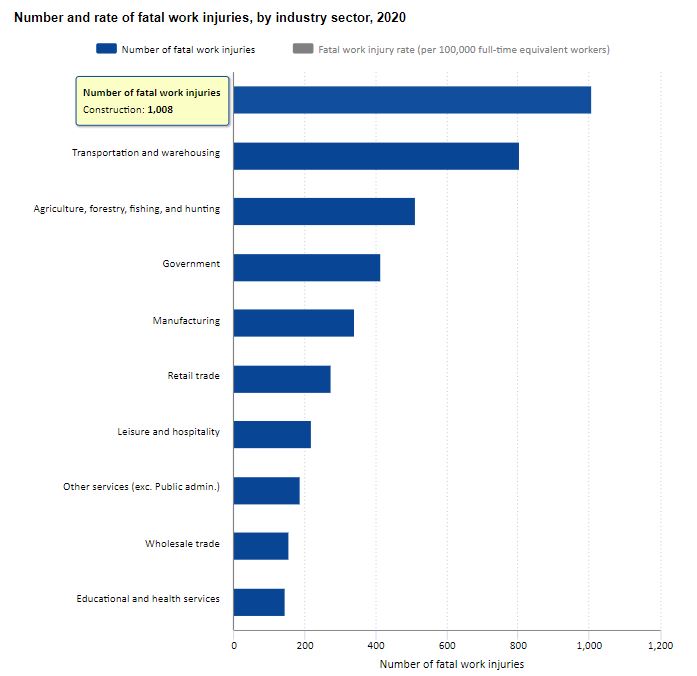Best Practices to Improve Construction Site Safety
Construction sites report around 1,50,000 accidental workplace injuries every year, which makes the construction industry one of the riskiest industries to work in, especially for on-site workers.
On top of this, construction workers operate in an environment full of heavy machinery, unsecured high-altitude working platforms, a high volume of material moving, open electric wires, and many potentially hazardous substances. Any accident can be life-altering and lead to serious injuries or even fatalities. Research done by the U.S. Bureau of Labour Safety supports this claim. Construction had over double the number of fatal work injuries when compared to Manufacturing.

Despite such an alarming standpoint of the construction industry, workplace safety is often and treated as a compliance function at construction sites. This article lists best practices one can implement for safety management at a construction site.
Let’s take a brief look
1. Risk identification
The idiom “Prevention is better than cure” is not applicable more than with constriction safety, but apply it is challenging. Identifying the possibilities of risk and being proactive towards mitigating it is the first and most important step anyone can take to avoid an accident, but there are diminishing returns when it comes to the number of risks identified.
But as we know, predicting risky situations and being proactive is easier said than done for humans. One is never going to capture every single possible risk, and documenting tens or hundreds of them will mean that most people will not be able to comprehend or remember them all. Thus leveraging AI enables technological solutions is the best way to risk identification and prioritization. The intelligent algorithms can quickly identify risky scenarios, prioritise them based on calculations from historical data, and broadcast alerts to inform workers and help mitigate accidental impacts.
2. Active supervision
No matter how much we try, there will always be gaps that can cause something to go wrong. Traditionally it was been seen as critical to supervise the site to look for these gaps and fill them up immediately, this policing mentality has given way to a more progressive ethos whereby positive behaiviours and outcomes are observed, and then efforts are made to encourage more of those. In this way, safety-related accidents and incidents can be avoided through the increase of positive outcomes rather then reduction of negative ones, it is a subtle but powerful distinction.
The good news is that technology is at our service for supervision as well. Installation of surveillance cameras embedded with machine learning capabilities can supervise the complete site with utmost accuracy, instead of using this technology to find indiscretions they can be used to spot positive behaviours which are far more numerous and so difficult for humans to capture in their entirety. Once captured, analysis on what caused the positive outcomes can be used to encourage and ensure more of this can be done.
3. Communication
Broadcasting vital information across every stakeholder on-site is crucial to ensure a safe environment. For example, any high risk observation noted during supervision should be broadcasted immediately to alert all the site workers and inform them about the risk.
One of Saifety messenger’s main features is its observation reporting feature embedded within the AI-enabled chatbot. On a construction site that has implemented Saifety.ai, every worker can report an observation from their device, which will be broadcasted in real-time to every worker on site if needed and as appropriate. This bi-directional flow of information, where data is collected, analysed and feedback to users, creates a virtuous loop of communication that can help derive a better understanding of the way work is actually conducted and therefore better planned in the future.
4. Worker Welfare
It is an unfortunate inevitability that incidents will occur, but instead of fearing them, due to reprisals or other perceived negative consequences, there needs to be a culture of no blame and shame developed. It is hoped that every worker should be in their best state of awareness when they report to work. An unaware worker has been shown to be one of the most dangerous triggers for accidents and incidents on-site. Again Saifety messenger can assist, it is not fair for workers to be expected to remember all the hazardous situations that can happen on-site, all the safety management protocols used, and all the remedies to act on in case of any incident.
Saifety.ai’s chatbot can be configured to ask pertinent questions about workers’ state of mind, and activities to be conducted and then respond with appropriate assistance, whether that be a joke to cheer up a lonely worker or a risk control protocol for a hazardous activity. Active and aware peers are the best defense against any hazard.
5. Safety training
Managers will implement all the above-mentioned safety management practices. But they will be enforced in action only by the workers. Thus, individual safety training is vital before appointing any worker on-site.
Regular safety training should be conducted that comprises the guide to enforce all the safety management protocols and train workers to be proactive in case of any incident on-site. However traditional safety training involves sending documentation via email, conducting quizzes, and multi-hour inductions among others, this is not how people consume information in their personal lives, most of which is done via social and chat-based applications.
Saifety.ai- Safety Management Platform for Construction Companies is on a mission to leverage the promise of conversation enhanced by Artificial Intelligence to save lives and reduce risk on construction sites. We are passionate about using technology to implement all the mentioned best practices for safety management on construction sites. Check out our features, and feel free to book a demo to understand how we are putting AI into safety.



